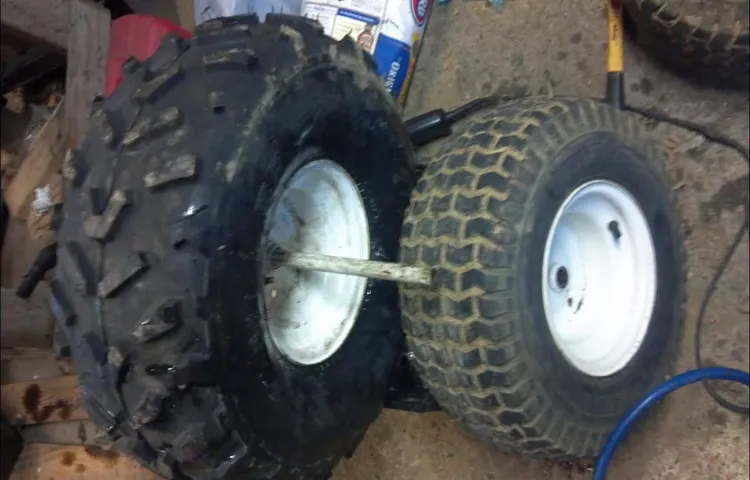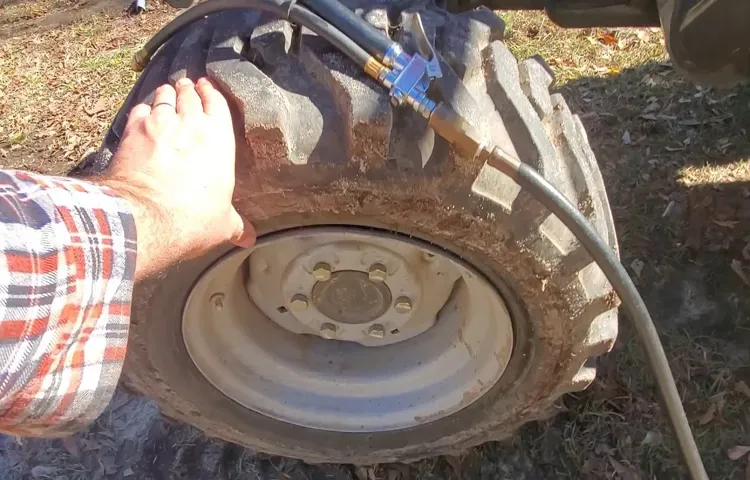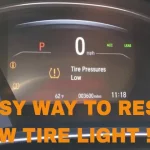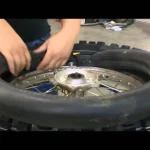Putting a tractor tire on a rim might seem like a daunting task, but with the right technique, it can be an easy process. However, there are some important tips and precautions you should know before attempting it on your own. Firstly, never attempt to put a tire on a rim that is not designed to fit together.
Doing so can cause serious damage to both the tire and the rim, potentially leading to unsafe driving conditions. Secondly, use a tire changer or other specialized equipment to make the job easier and safer. These tools can help you hold the tire in place while you work on getting it onto the rim.
Thirdly, be aware of the type of tire you are working with. Different tires may have varying levels of flexibility, and some may be more difficult to work with than others. Lastly, take your time and be patient.
Rushing the process can result in mistakes and potentially dangerous situations. With these tips and techniques, putting a tractor tire on a rim can be a manageable and successful task.
Table of Contents
What You Need
Putting a tractor tire on a rim may seem like a daunting task, but with the right tools and techniques, it can be done in no time. Before you begin, make sure you have all the necessary tools, such as a tire iron, a hammer, and a valve stem remover. It’s also important to have a clean and dry work area and to take all necessary safety precautions, such as wearing gloves and safety glasses.
Start by laying the tire on its side and removing the valve stem with the valve stem remover. Next, use the tire iron to pry the tire away from the rim on one side, being careful not to damage the tire bead. Once you have the first side of the tire removed, use the same technique to remove the other side.
With the tire removed, it’s time to put the new tire on the rim. Begin by setting the tire on the rim and lining up the valve stem hole with the rim’s valve stem hole. Next, use the tire iron to slowly work the tire onto the rim, being careful not to pinch the tube.
Finally, inflate the tire to the recommended pressure and check for any leaks. With these steps, you’ll have a new tractor tire mounted onto your rim in no time.
Tractor Tire
If you own a tractor, it’s crucial to have the right tires for your vehicle. Out of all the tires on a tractor, the ones on the rear axle are the most important. The rear tires provide traction and stability for the tractor while working in the fields.
To choose the best tractor tire, you need to consider the type of soil you’re working with, the weight of the tractor, and the type of work you’ll be doing. The tire size and tread pattern are also significant factors that need to be taken into account. A tire that is too large or too small for your tractor will cause problems, such as reduced traction and a shorter lifespan.
A twisted or worn tread could cause your tractor to struggle in muddy fields or lose its grip when climbing hills. To avoid these issues, it’s best to consult with a tire expert who can help you select the right tire for your particular needs. With the right tire, you can ensure your tractor operates safely and efficiently in all conditions.

Rim
When it comes to rims for your car, there are a few things you need to consider before making a purchase. First, you should determine the correct size for your vehicle. You don’t want to end up with rims that are too small or too large for your car.
Second, you need to choose the material that best suits your needs. Different materials, such as aluminum or steel, will affect the weight and durability of your rims. Third, you might want to consider the style and design of the rims.
Do you want a sleek and modern look or a more classic style? Lastly, you should also factor in your budget. Rim prices can vary widely depending on the size, material, and style you choose. By keeping these things in mind, you’ll be able to find the perfect rims for your car that not only look great but also perform well on the road.
Lubricant
When it comes to using lubricant, there are a few things you need to know before you start. Firstly, it’s important to choose the right type of lubricant for your needs. Water-based lubricants are the most popular choice as they’re safe to use with condoms and sex toys, and they’re easy to clean up after.
However, if you’re looking for something longer-lasting, silicone-based lubricants are a good option. Just make sure not to use them with silicone toys as they can damage the material. Another thing to consider is the ingredients in your lubricant.
If you have sensitive skin, it may be worth choosing a lubricant that’s free from fragrances, glycerin, or parabens. Some people may also prefer organic lubricants made from natural ingredients, such as aloe vera or coconut oil. Lastly, it’s important to apply lubricant correctly.
Be generous with the amount you use, and don’t be afraid to top up if needed. You can apply it directly to your genitals or sex toys, or onto your partner’s body. Remember to reapply as necessary, especially if you’re engaging in prolonged or vigorous sex.
With these tips in mind, you can enjoy a more comfortable and pleasurable sexual experience with the right lubricant.
Tire Irons
If you’re an avid cyclist, then you know that having the proper tools is crucial when it comes to maintaining your bike. One of the essential tools you’ll need is a tire iron. These handy little tools help you remove and install tires on your rims easily, making tire replacements and repairs a breeze.
When it comes to choosing the right tire iron, there are a few things to keep in mind. Firstly, look for a durable and sturdy tire iron that can withstand repetitive use. Secondly, consider the size of the tool and ensure it’s suitable for your bike’s tire size.
Thirdly, the shape of the tool should be comfortable to grip and have a straightforward design so that you can use it efficiently. Overall, having the right tire iron in your arsenal of tools will make maintaining your bike a whole lot easier.
Steps to Follow
Putting a tractor tire on a rim can seem like a daunting task, but with the right tools and steps, it can be done efficiently and safely. Firstly, it’s important to make sure the tire and rim match in size and style, as this will prevent any further complications down the line. Next, use a tire iron to remove the old tire from the rim, being careful not to damage the rim or puncture the new tire.
Once the old tire is removed, place the new tire over the rim and use a tire mounting machine or tire irons to secure it in place. Finally, inflate the tire to the recommended pressure and check for any leaks or defects before use. While it may take some practice, following these steps will ensure a successful tire installation and a safe operating vehicle.
Step 1: Lubricate the Tire Bead
One of the first steps to properly inflate a tire is to lubricate the tire bead. This is especially important when dealing with stubborn or older tires. Lubricating the bead area will make it easier to slip the tire onto the rim.
There are different types of lubricants you can use, including soapy water, silicone spray, or beeswax. Soapy water is the most common lubricant used, but it dries out quickly and may cause corrosion if not cleaned up properly. Silicone spray is a more long-lasting option, but it can be messy and harder to clean up.
Beeswax, on the other hand, is a natural lubricant that won’t damage the tire or rim. Whichever lubricant you choose, be sure to apply it generously around the entire bead before installing the tire onto the rim. This will prevent any damage to the tire or rim and make the installation process smoother and more efficient.
Step 2: Position the Rim and Tire
Positioning the rim and tire is a critical step when it comes to installing new wheels on your car. Firstly, ensure that the old tire and rim are removed and that the new ones are clean and free of debris. Then line the new rim and tire up with the wheel studs, ensuring that the holes on the rim are aligned with the studs.
Begin by hand-threading the lug nuts onto the studs, making sure they are tightened evenly. Use a torque wrench to fully tighten the lug nuts to the manufacturer’s recommended torque rating, which can be found in the vehicle owner’s manual. It is important not to over tighten the lug nuts, as this can cause damage to the threads and potentially lead to wheel failure.
Once the rim and tire are properly positioned and tightened, it’s time to double-check everything before hitting the road. Take a test drive around the neighborhood and listen for any unusual noises or vibrations. Overall, make sure to take your time and be meticulous during this step to ensure a safe and enjoyable ride.
Step 3: Insert the Tire Irons
Inserting tire irons into the tire is an essential part of changing a flat tire. This step may seem challenging, but with the right technique, it can be done easily. To begin, make sure you have positioned the jack correctly and lifted the car off the ground.
Next, locate the small groove where the tire iron will fit. Take one of the tire irons and position it in the groove. Push the iron towards the car, so it hooks onto the rim.
Repeat the process with the second tire iron on the opposite side of the first iron. With both tire irons in place, twist them towards you. This will loosen up the rim from the tire.
Once the tire irons are in position, you are ready to continue with the next steps. Remember to be careful when using the tire irons, as they can be sharp. With these simple steps, you can easily insert the tire irons and change your flat tire in no time.
Step 4: Pry the Tire onto the Rim
Finally, it’s time to get that tire onto the rim! This step might seem daunting, but with a little effort and perhaps some finesse, you can get it done. Start by placing the tire onto the rim as much as possible, lining the bead up with the corresponding rim edge. From there, you can use a tire lever or a similar tool to carefully pry the tire onto the rim.
Take care to work slowly and methodically, pushing the tire bead towards the center of the rim as you go. As you work, you may need to stop and adjust the position of the tire, making sure everything lines up correctly and there are no bulges or gaps in the assembly. With perseverance and patience, you’ll soon have your tire back on the rim and ready for action.
Step 5: Repeat on the Other Side
As you finish up one side of your project, it’s time to repeat the process on the other side to ensure balance and symmetry. This step is just as important as the others because it guarantees that your finished product looks cohesive and well put together. Make sure to use the same measurements you used on the first side to keep everything even and consistent.
Keep in mind that some details might not line up perfectly, especially if you’re working with irregular shapes or measurements, but that’s okay. Just do your best to match the other side as closely as possible. And, if you do notice any discrepancies, try adjusting your process on the second side to get a better match.
With a bit of practice, you’ll quickly get the hang of repeating the process on the other side and creating balanced and beautiful projects every time.
Final Thoughts
Putting a tractor tire on a rim may seem like a daunting task, but with the right tools and technique, it can be done quickly and efficiently. Firstly, the tire and rim must be thoroughly cleaned to ensure proper adhesion and prevent any damage. Next, the bead of the tire should be placed into the center of the rim and secured using a ratchet strap or clamps.
One side of the tire can then be manually pushed over the rim with the help of a tire iron, before the other side is carefully guided onto the rim using a tire mounting machine or air compressor. Finally, the tire pressure can be adjusted to the manufacturer’s recommendations, and the tire can be balanced for optimal performance. By following these steps, anyone can successfully put a tractor tire on a rim without any hassle.
Conclusion
In conclusion, putting a tractor tire on a rim may seem like a tough task, but with a little determination and the right tools, it’s just like putting a puzzle piece in place. It requires patience, a bit of elbow grease, and the ability to think creatively and flexibly. So the next time you’re faced with the challenge of putting a tire on a rim, simply channel your inner puzzle solver and trust that you have what it takes to get the job done!”
FAQs
What tools do I need to put a tractor tire on a rim?
You will need a tire iron, a valve stem tool, and a rubber mallet.
How do I remove an old tractor tire from the rim?
Use a tire iron to loosen the tire from the rim and then use a rubber mallet to force it off.
Can I put a tubeless tire on a rim without a tube?
No, tubeless tires must be mounted with a tube on a rim.
What size rim should I use for my tractor tire?
Consult your tractor’s manual or a tire professional to determine the appropriate rim size for your tire.
How do I inflate a tractor tire?
Use a compressor or pump to inflate the tire to the recommended pressure listed on the tire.
What is the recommended tire pressure for my tractor tire?
Refer to your tractor’s manual or the tire manufacturer’s guide for the recommended tire pressure.
Can I mount a tire on a rim myself, or do I need a professional?
You can mount a tire on a rim yourself, but if you are unsure or inexperienced, it is recommended to seek the assistance of a professional.



